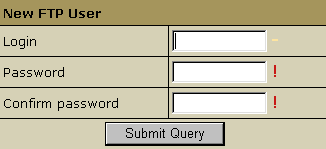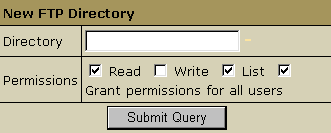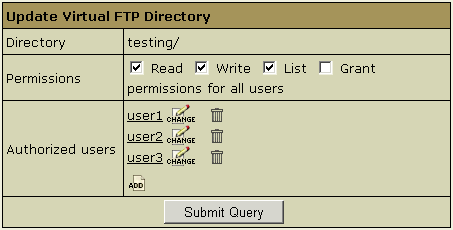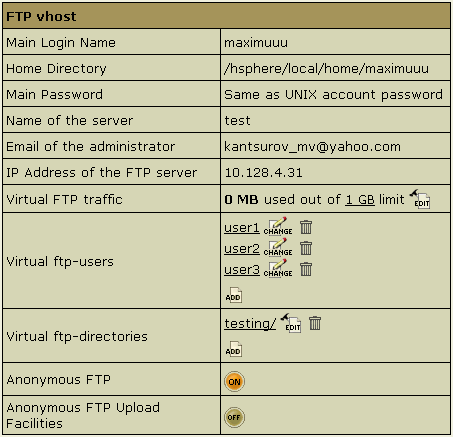FTP: Sharing Access to Your
Home Directory With Others

There are three ways to allow guest users to download, upload or view
files in dedicated directories of your account:
FTP
Subaccounts (available
only for Unix based accounts)

The simplest way to authorize your friends or colleagues to work with
particular directories of your account is to create FTP subaccounts. An
FTP subaccount is a combination of a username and a password, which gives
full FTP permissions to a single directory, without giving access to the
root directory, other directories or the control panel. No dedicated IP
is required for FTP subaccounts. Although each FTP subaccount has a login
which is different from yours, both have the same ID in the system.
To create a new FTP subaccount:
- Select FTP User link in FTP/User Account
menu.
- At the bottom of the page that shows, find FTP
sub-accounts and click the Add icon.
- On the next page, enter the FTP login and password
that will be used by this other user, and the directory this user will
be restricted to.
The directory must be relative to your home directory. If you leave
the directory field empty, FTP sub-users will have access to your
whole home directory.
FTP subaccount traffic is a part of the Total/Summary traffic, but you
can always see how much FTP traffic has been run up by an individual FTP
subaccount by going to the FTP Manager page and clicking the Edit
icon next to the subaccount login.
Virtual FTP
Virtual FTP provides ampler possibilities than FTP sub-accounts. You
can give your authorized Virtual FTP users access to more than one directory
and specify a different set of permissions for each directory. Virtual
FTP users log right into your root, but can enter only those directories
you allow them to enter.
To provide Virtual FTP Access to a certain domain, do the following:
- Skip this step if
you are already using a dedicated IP.
Select FTP in FTP/User Account menu.
- If you have several domains, choose the one to enable
virtual FTP for.
- On the page that appears, switch to dedicated IP.
Click here to read
about the difference between shared and dedicated IPs.

- Click the confirmation link to agree with the charges.
- On the next page, add server name for the new virtual
host. This name will appear in the welcome message when guest users connect
to your server with FTP clients. Also, enter the e-mail address by which
FTP users can reach you with questions or comments.
- Click the Edit icon for FTP for this domain.
-
Click the Add icon for Virtual FTP Users and create a
new Virtual FTP User:

-
Click the Add icon for Virtual FTP Directories and enter
the name for the new Virtual FTP Directory:

End it with a slash, e.g.: Dir1/. The location must be specified
relative to root. To create a virtual FTP directory inside a different
directory, include the path, for example UserDirs/Dir1/.
On the same page, specify permissions to this directory:
Read: check to allow file downloads from this directory.
Write: check to allow file uploads to this directory. List:
check to allow viewing / browsing the contents of the directory. It is
usually used jointly with Read.
Grant Permissions to all users: check to grant these permissions
to all your Virtual FTP users. If you leave this property unchecked, you
will have to define permissions on this directory individually for each
Virtual FTP User.
-
Click the Edit icon next to the directory you have just created.
If you haven't granted the same permissions to all your Virtual FTP Users,
you can specify permissions for each of them individually:

If you have chosen to grant the same permissions to all users, you
can skip this step.
Anonymous FTP
This feature allows you to give public FTP access to a dedicated directory
in your account. A special directory is created in your root, and its
content can be viewed and downloaded, but not uploaded.
Do
you need Anonymous FTP? If
you want to allow a user to upload and
download, then we recommend using FTP Subaccounts and not
Anonymous FTP.
Anonymous FTP becomes available only after you create a Virtual FTP
server. To configure Anonymous FTP, do the following:
- Skip this step if
you are already using a dedicated IP.
Select FTP in FTP/User Account menu.
- If you have several domains, choose the one to enable
virtual FTP for. On the page that appears, switch to dedicated IP. Click
here to read about
the difference between shared and dedicated IPs.
-
Skip this step if you have already enabled
Virtual FTP.
Select FTP in FTP/User Account menu. Enable FTP for this domain:

and agree with the charges.
-
On your control panel home page, select FTP in FTP/User Account
menu. Enable Anonymous FTP for this domain:

You can also enable Anonymous FTP on the FTP vhost page.
If you want to allow anonymous FTP users to upload files, enable Anonymous
FTP Upload Facilities by doing the following:
- Enable Anonymous
FTP.
-
At the bottom of the FTP vhost page you will find a new option
to enable anonymous FTP upload facilities:

Turn it on. This will create a dedicated directory inside the Anonymous
FTP directory.
* The Uploads (Windows based plans) / Incoming (Unix based plans) directory
have only 'upload' permissions, so it will allow neither downloading nor
viewing its content.
- To upload files to the folder, use Webshell or any
ftp program and login to your server. Your
root directory will have a folder with 6 number (ex. 768426) This is the
folder to upload your files so that they may be viewed through anonymous
ftp.







